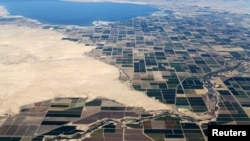Four years ago, Maeve Taylor and her husband decided to quit their jobs and move their family across the United States to start an organic dairy farm in New York.
The couple used a federal loan to buy 35 cows and started to learn their new trade on a patch of rented farmland.
But when they began looking for land of their own they hit their first major hurdle. Even in an area with a long agricultural tradition and lots of farmland, there was nothing to buy — at least at a price they could afford.
"You'd think you could buy something, but hardly any of it is for sale," Taylor told the Thomson Reuters Foundation. "Wealthy landowners ... live here as retirement homes or have purchased property as a vacation home."
More than 31 million acres (12.5 million hectares) of U.S. farmland were lost between 1992 and 2012, according to a major assessment released this week by the American Farmland Trust — double previous estimates.
The advocacy group found nearly two-thirds of all U.S. development during that period was on farmland, taken over primarily by the expansion of urban areas and by low-density housing.
Experts say new farmers are being priced out by developers and the rural landscape risks being radically transformed as farms are split or sold as real estate, unless the government is prepared to safeguard agricultural property.
"We're at a time in history where farmland isn't being bought by farmers," said Holly Rippon-Butler at the National Young Farmers Coalition, an advocacy group. "Our limited agricultural resources could be lost to agriculture forever. That's the urgency."
Nearly 100 million acres — 10 percent of agricultural land in the United States — is expected to change hands by the end of the decade as elderly farmers retire, according to a 2014 government estimate, the first of its kind.
The average age of U.S. farmers — and agricultural landholders — has been steadily rising, to the point where today many are looking to secure a comfortable retirement.
Almost two-thirds of U.S. farmland is now managed by someone over 55, and farmers older than 65 now outnumber those under 35 by a sixfold margin, according to the Young Farmers Coalition, citing federal statistics.
"Significant challenge"
The looming changeover in landholdings could be an opportunity for new farmers wanting to buy. But most agricultural lands are kept within families or sold to acquaintances, not on the open market.
Less than a quarter of the nearly 100 million acres of agricultural land that will change hands is expected to be sold to a non-relative, according to the 2014 federal findings.
Another 58 million acres is expected to be passed down through farming families.
Taylor said she and her husband were repeatedly turned away by sellers who pointedly told them that they wouldn't be able to afford the asking price.
Eventually, driven by falling prices for organic dairy products, they decided to sell their cows in order to pay off their loan — a story that appears to be increasingly common.
Last year, the Young Farmers Coalition surveyed U.S. farmers aged under 40 to gauge how they were fairing. The findings were stark. Almost 40 percent of respondents cited land access as a "significant challenge" — the survey's most-cited concern.
Real estate values for farms more than doubled from 2000 to 2015, U.S. Department of Agriculture research found in February.
Meanwhile, farm incomes stayed relatively flat, particularly after commodity prices fell in recent years. A study released in September found that the value of farm production compared with farm real estate is at its lowest point ever recorded.
Opportunities
Campaigners are now looking to lawmakers debating updates to what is commonly known as the farm bill, which expires in September.
The new five-year bill, a draft of which was released in mid-April, could offer strategies to address the issue.
While local-level zoning regulations already seek to protect farmland in the United States, experts say it is not difficult for developers to change the designation — and almost unheard of for it to be changed back again.
"In general, once you transfer land out of farming, it's very difficult if not impossible to bring it back into farming," said Juli Obudzinski, deputy policy director with the National Sustainable Agriculture Coalition.
Even if land continues to be farmed, Obudzinski said spiking real estate values meant it was more likely to be bought up by existing farmers than new ones looking to get into the sector, and called for a national strategy on the looming transition.
"Otherwise, our concern is that these lands will just go to the biggest farms and the highest bidders, increasing consolidation and decreasing the viability of rural communities," Obudzinski said.
Still, the aging of U.S. agricultural landholders does offer potential opportunities.
Maeve Taylor's family is now in the process of purchasing land in nearby Vermont, close enough that they won't have to move.
The transaction is being facilitated by the Vermont Land Trust, which matched the Taylors with a farming family who wanted to sell.
It structured the sale in such a way that the land would be affordable to the Taylors, using a mechanism under debate in the farm bill discussions.
The owners had been raising organic wheat for nearly four decades, Taylor said, supplying it to nearby bakers. Now, they wanted to retire and ensure that their business continued.
The land sale is expected to take place this month, and Taylor expects to be farming organic wheat by summer.






